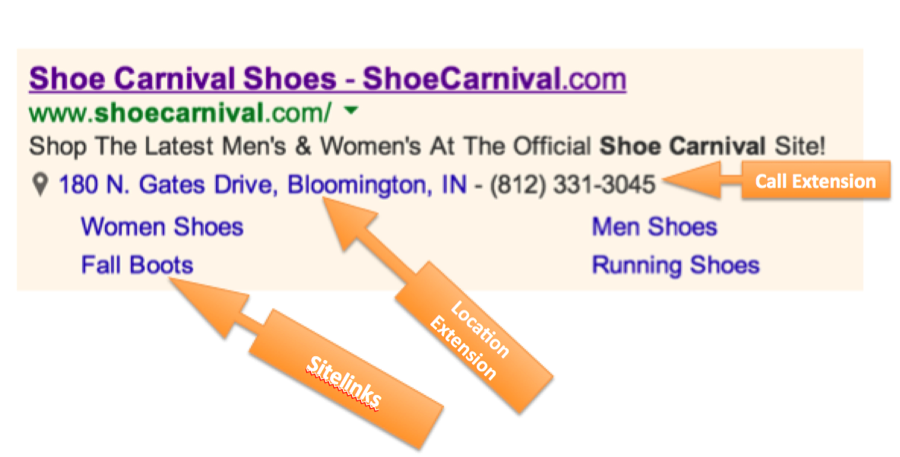This past month we saw the big release of Google’s new approach to your ad position: the Ad Rank Algorithm. This algorithm now looks at an additional factor, expected positive impact of an ad, when determining which ad will show and where. When an auction used to be determined by Quality Score and max. CPC, now if both of those factors are equal, Google will turn to the expected impact (i.e. effectiveness) of your ad to choose the ranking.
As a refresher for those of you with a little less hands-on account work, Ad Rank previously represented the product of your Quality Score and your maximum Cost-per-Click.
If you had a low ad rank, you might have tried to bid up your keyword or improve your QS (through improved CTR, ad relevance or landing page relevance).
What’s changed, you ask? How have the Googs complicated this enigmatic metric we know as ad rank? By incorporating a new factor into the calculation: Ad extension performance.
Ad extension performance is Google’s interpretation of the how users who see your ads interact with the various extensions you’ve tied to your ad copy. This could range from sitelinks to location extensions to call extensions and on. The more the merrier, my friends. And what do I mean by user interaction? By this we mean not only the CTR associated with each extension, but the quality of activity on the other side of the click.
So you’re looking at your account and you see that you have a fairly strong Quality Score, decently competitive max. CPCs and some extensions that you enabled 6 months ago. Good, right? WRONG. Not only is this selling yourself short (ad extensions are great!) but also the competition is suddenly going to get way more intense.
Let’s start with some of the simplest forms of ad extensions: 
Here we see Sitelinks, Location Extensions and Call Extensions. Easily some of the quickest wins when utilizing extensions.
Sitelinks: These little guys are one of the most effective ways to get folks to the various layers of your site. You may want to include sitelinks that take people to content or category-specific pages, such as in the ad above. You may also want to help users find the answers that will allow them to move forward in the conversion process, such as the ad below. Either way, the biggest highlight is that your sitelinks need to resonate with those who see your ad. Keep this connection strong, as you’re gonna need it when the auctions begin!
Bonus! Sitelink Descriptions: The ad below also includes the gems we call Sitelink Descriptions. It is considered a best practice to utilize your sitelink descriptions in some way, shape, or form, as the inclusion of them does nothing but help you! As always, we encourage plenty of testing, so try your sitelinks without descriptions, and then vary your messaging. It’s possible that, like any aspect of PPC, you may discover a great source of user activity through the simple testing of a message. 
Location Extensions: The location extension is the simplest bridge between brick & mortar businesses and their online advertising efforts.
Call Extensions: One of my personal favorites, the call extension can be your direct number, a Google forwarding number, or a trackable number (through a 3rd party service). Either way, the call extension provides a number that can connect a user with your agent without any clicking or further browsing. Depending on your degree of call tracking, this could be one of the best investments you make in your ad extensions.
Bonus! Click to Call Extensions: Like I said, these are some of my favorites, and Click-To-Call extensions provide mobile browsers with an easily selected “Call” button. Done and done. And again, depending on the nature of your tracking, you may get all sorts of useful data for optimizing the campaign, keyword, or ad that led to this call.
How does the new Ad Rank Algorithm affect your extensions? What should you be doing that you’re not yet doing to keep your ad rank in peak condition?
With CTR as a strong indicator to the user’s connection with your ad, consider how you customize your sitelinks. Are you simply putting the same four Learn More/About Us/FAQ/Contact Us sitelinks on all of your campaigns? The best way to begin identifying that which will resonate with your users is to identify the paths they are on. If you are selling baked goods, as well as baking supplies, consider the keywords you’re associated with these users.
If a portion of your site if dedicated to fresh-baked cookies, for example, consider what the user might be hoping to accomplish. Perhaps your users are looking for your coveted recipes, or a gallery of your best cookies. Maybe they’ve seen your retail shop and want to follow-up by buying some of your famous cookie cutters, or they just want to order some tasty treats for a loved one. By providing them with direct links to various pages within your site, you are enabling the conversion process to occur that much more quickly.
Similarly having a call extension on your mobile ads may be an easy way for mobile users to be in touch with you, but even better is having ad copy that compels them to call immediately! Are you reminding them of the promotion that will be ending soon? Perhaps the inventory is limited? What kinds of details can you include in your ad copy that will not only peak their interest, but also get them to dial through to your business? As we enter the holiday season – a time during which many online marketers experience some form of seasonality – it is critical that you’re keeping things as conducive to converting as possible.
Now the ad rank ball is in your court:
When your ads show up, they will appear in a position that is a result of your QS, your bid, and the “expected positive impact” Google anticipates your ad will have.
Your data will allows Google to know which combination of extensions will be most advantageous at each auction.
If you’re not already keeping an eye on the relationship between your average position and your average CPC, now is the time to do so. With the new algorithm, you have that many more ways to improve (or fail to improve) your position. As you optimize your extensions for best performance, keep an eye on how your quality score and ad rank change.
All of these changes continue to show us that Google is serious about utilizing their tools to get users engaged in a productive way. You may have held off on investing in ad extensions in the past, but you’re not getting away with it any more!




